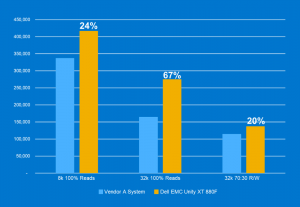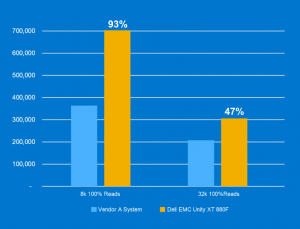The success or failure of many storage solutions is often determined by an array’s performance across a variety of workloads. A modern storage array must concurrently deliver performance, data reduction and data services, enabling organizations to deliver increased efficiencies and thrive in today’s complex application environments. The Dell EMC Unity product line has already delivered on these capabilities by increasing data reduction rates by ~80% since initial release (December 2016). And now with the recently refreshed Unity XT, we’re raising the bar yet again.
In order to quantify all of the enhancements we’ve made with Unity XT, we asked Principled Technologies (PT) to independently conduct hands-on performance testing, with and without data reduction, between Unity XT and its primary competitor we’ll call Vendor A. This testing confirms that Unity XT, with its modern architecture and hardware enhancements, beats a leading storage competitor in three different performance and data reduction scenarios.
 Scenario 1: Performance with Data Reduction Turned On
Scenario 1: Performance with Data Reduction Turned On
In this test, data reduction (compression and deduplication) was activated on both systems to maximize storage efficiency and space. This is especially significant when working with virtual servers, file system data, archival and backup data or email systems containing multiple instances of the same file attachment. While Unity XT data reduction is always inline to support data-intensive workloads, at a certain threshold Vendor A disables inline deduplication. With data reduction turned on, Unity XT was 24% faster at 8k IO block size/100% Reads and 67% faster at 32k IO block size/100% Reads than Vendor A. If you’re looking for an analysis of workload performance based on a more common scenario, Unity XT also beat out Vendor A by 20% in a 70:30 R/W mix.

Scenario 2: Performance with Data Reduction Turned Off
In this test (8k IO block size and 100% Read), with data reduction turned OFF on both systems, Unity XT’s raw performance for data-intensive workloads was 93% better than Vendor A. Unity XT also proved to be 47% faster at 32k block size and 100% Reads. While most of our customers would enable data reduction, there are primary datasets that are not necessarily impacted by array-based data reduction such as music/audio, photo, and video files along with certain types of Big Data like telemetry and genomic files, which all tend to be compressed by default in software. Therefore, this test is an illustration of the overall raw performance of each system’s ability to handle these data types.
Scenario 3 Results: Data Reduction Under Same Performance Load/Data Set
In this test, both arrays were placed under the same load at 70K IOPS, 8k IO block size and 100% Writes. The goal of this test was to isolate data reduction efficiency and keep all other variables equal. Unity XT 880F’s data reduction rate came in at 7:1 or 129% better than Vendor A’s 3.05:1 rate. During the 3-hour pre-fill process, Vendor A’s system seemed to halt its inline data reduction process to preserve IOPS.

No compromise midrange storage
Unity XT’s powerful capabilities allow it to run virtualized applications, support inline data reduction and deliver unified data services – simultaneously. Our customers have long told us they value Unity for many reasons, including:
- Storage lifecycle simplicity from ordering to support
- Unified architecture (file and block)
- Dual-active controllers
- Investment protection with the Future Proof Loyalty Program
Now that the results are in, you can add these significant performance and data reduction advantages to the long list of reasons why customers choose the Dell EMC Unity family. With the storage system from Vendor A, customers will have to choose between performance OR efficiency. With Unity XT systems, our customers get both – without compromise.
For more, you can read the full PT report here and an accompanying video here.
